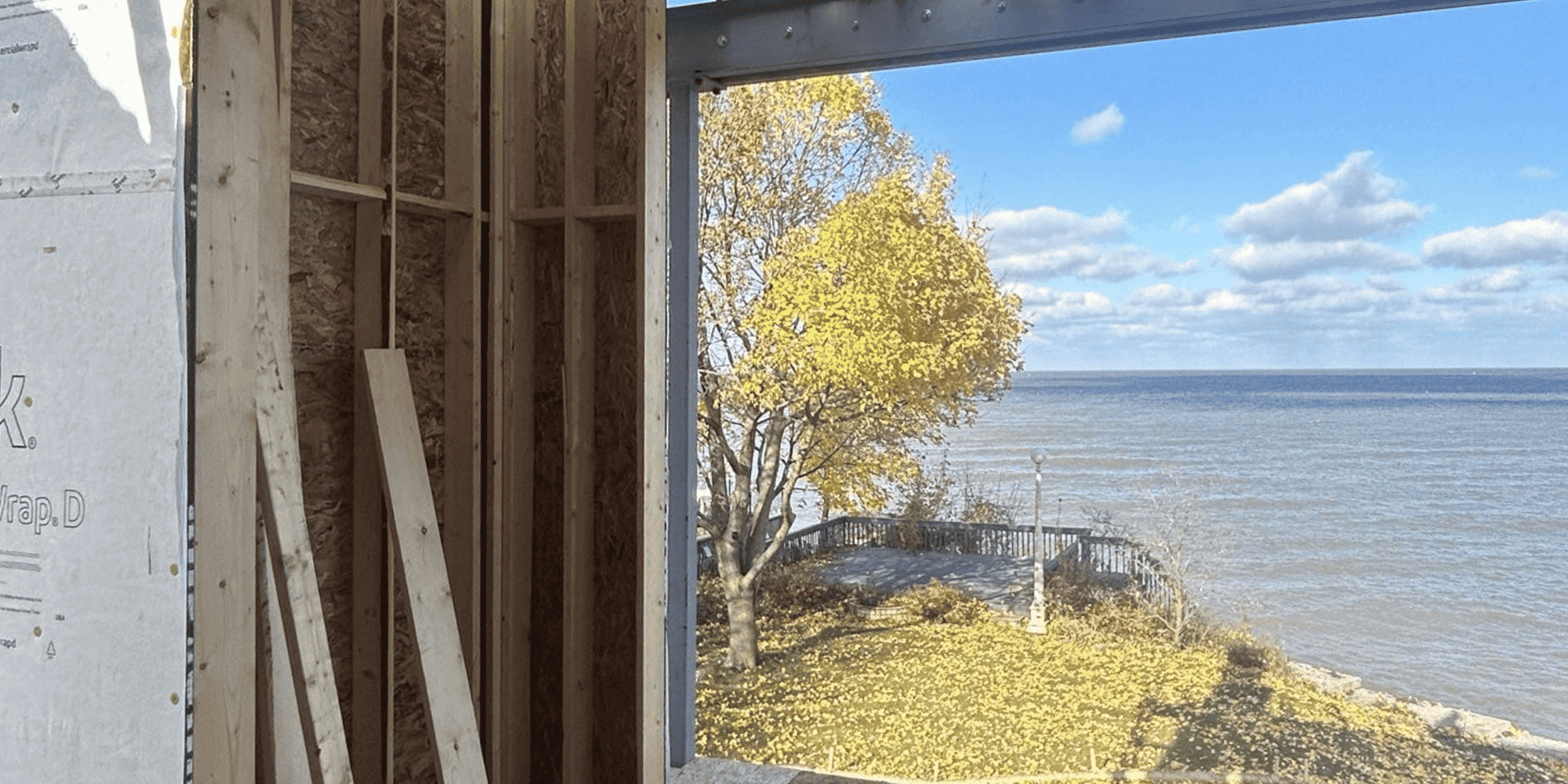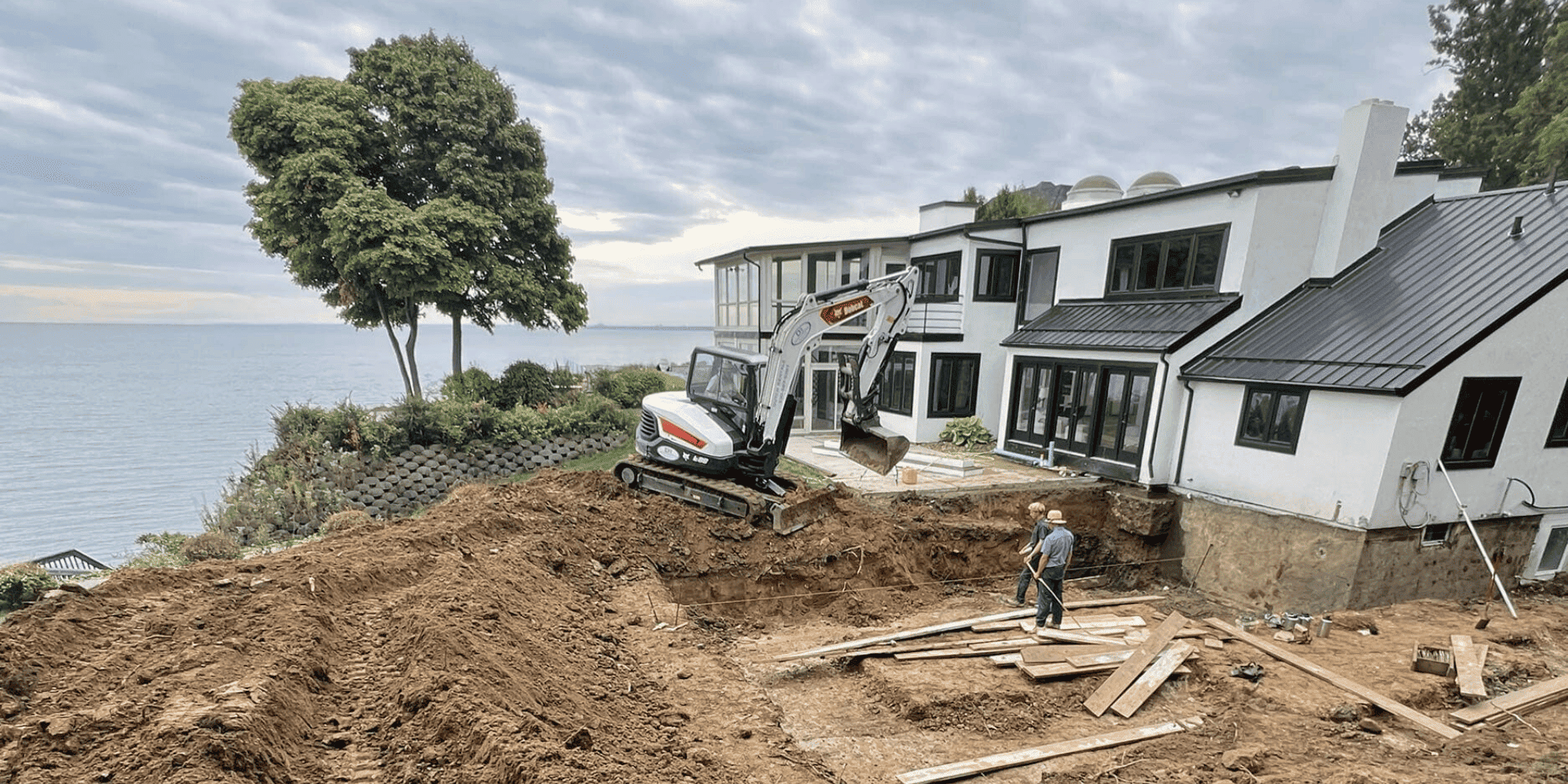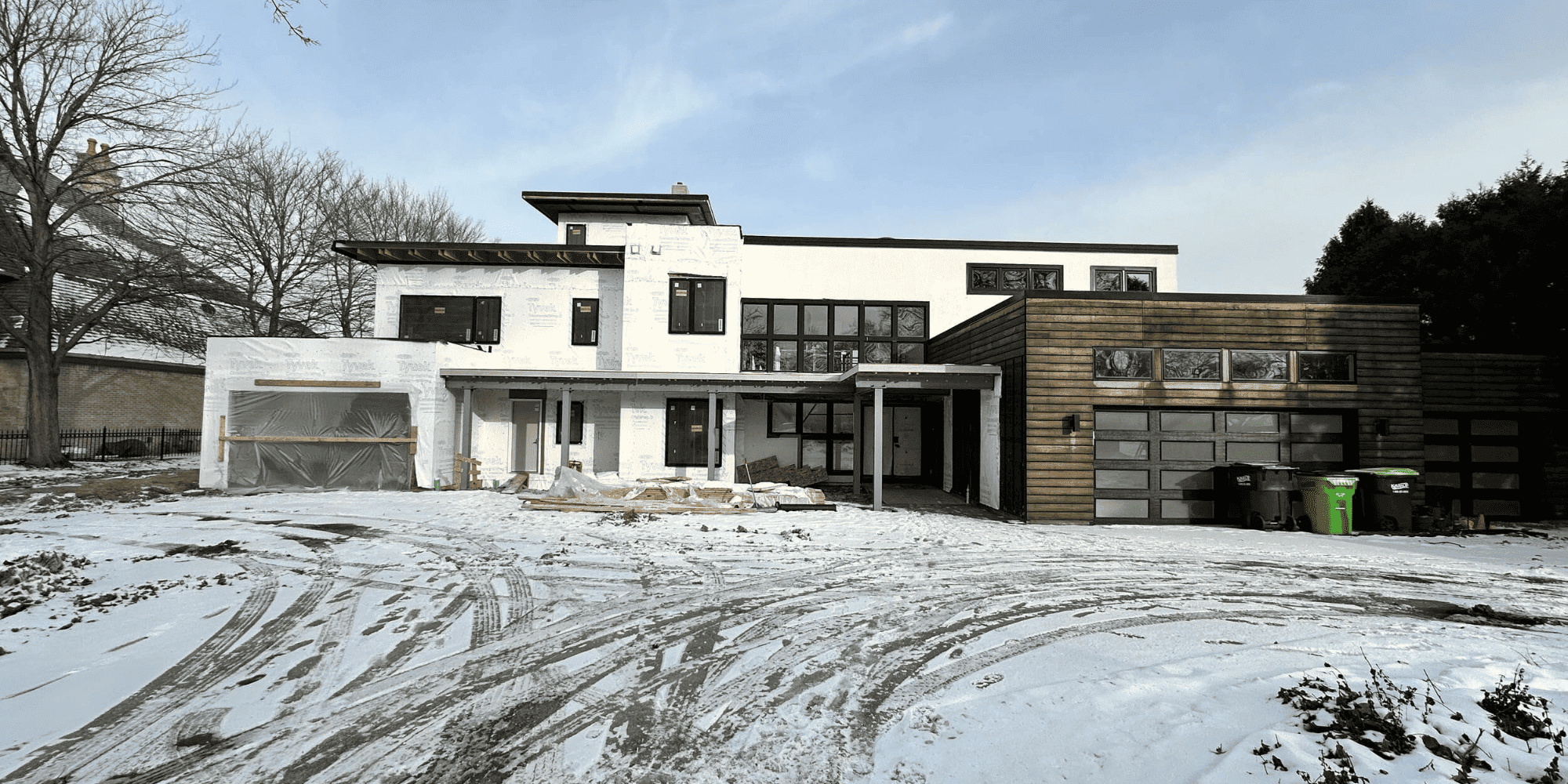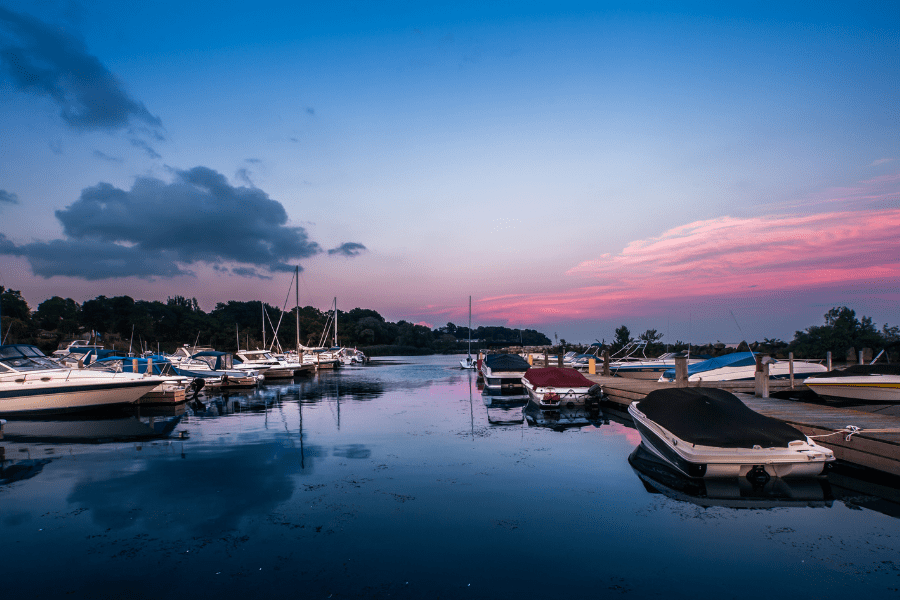12 Essential Features Every Luxury Lakefront Home Should Have
Let’s be real: waterfront living comes with its fair share of challenges. That's where the right materials and building techniques come into play.
Constant moisture, harsh winter weather, and the wear and tear of lakeside elements mean your lakefront home may need an update so that it's built to last.
With the right materials, thoughtful planning, and strategic upgrades, your lakefront home can be as durable as it is beautiful. These essential features will help you create a home that’s perfectly suited for lakefront living—so you can spend more time enjoying the water and less time worrying about maintenance.
Remodel Your Lakefront Home With Smart Upgrades
If your lakefront home is missing these materials, it won't withstand the harsh conditions of its lakeside location long. Choose a remodeler who's a pro at updating lakefront homes for longevity, including these materials:
1. Weather-Resistant Siding
If you’re building or remodeling a lakefront home, durable siding is a must. With all the moisture in a lakeside environment, you need materials that stand up to the elements without constant upkeep.
Fiber cement, composite wood, and high-quality vinyl are some of the best options for resisting moisture, preventing rot, and keeping your home looking sharp for years. The right siding enhances your home’s style and longevity, so you can focus on lake days, not maintenance.
2. Treated or Composite Wood
Your deck, dock, and exterior trim are constantly exposed to water, humidity, and sun.
Using pressure-treated wood, composite decking, or naturally rot-resistant species like cedar or ipe ensures that these outdoor features remain sturdy and beautiful.
For homeowners looking for lake patio ideas that combine durability with style, composite materials offer a sleek, low-maintenance option that is perfect for modern living.
3. Metal or Composite Roofing
A strong roof is essential for any home, but especially for one near the water. Metal roofing—such as aluminum or galvanized steel—is highly durable against wind, rain, and humidity, making it a necessity for any modern lakefront home.
Not only does it provide long-lasting protection, but its sleek design also complements the best designs, adding a touch of sophistication to your property.
4. Corrosion-Resistant Fasteners
It’s the little things that make a big difference in a lakefront home. Stainless steel and galvanized nails, screws, and brackets might not be the most flashy part of your remodel design, but they’re essential for keeping your home solid in a high-moisture environment.
Without corrosion-resistant fasteners, rust can creep in and weaken your home’s structure over time. These small but mighty details help ensure your luxury lakefront home stays strong, secure, and built to last.
5. Concrete or Stone Foundations
A solid foundation is non-negotiable when building near water. Reinforced concrete piers or slabs are designed to withstand shifting caused by water exposure and soil movement.
This feature is especially important for homes located on sloped terrain or near shorelines, where erosion can be an issue. Pair this with thoughtful lakefront landscaping ideas, such as retaining walls or terraced designs, to further stabilize your property.
6. Impact-Resistant Windows
Strong winds and storms are part of life on the lakefront, so protecting your home with impact-resistant windows is essential.
Hurricane-rated or tempered glass windows not only safeguard your property but also enhance energy efficiency, keeping your home comfortable year-round while preserving those stunning views that make lakeside living so appealing.
7. WaterProof Insulation
Humidity and moisture can wreak havoc on traditional insulation materials like fiberglass. Closed-cell spray foam insulation is a far better choice for lakeside homes because it resists moisture and mold growth while providing superior thermal performance.
This feature ensures your home stays cozy in winter and cool in summer—a must-have addition to your list of waterfront home ideas.

Are Lakefront Houses Built Differently Than Inland Houses?
Inland homes just don't have to live up to the same demands as lakefront homes. In addition to the materials listed above, these building methods will keep your lakeside home dry and resilient:
1. Elevated Foundations
If your lakefront property sits in a flood zone, an elevated foundation is a must.
Work with your architect to decide whether to build on stilts, piers, or raised concrete. A lifted foundation keeps your home high and dry while adding a touch of architectural flair.
Beyond protecting your investment from water damage, it also opens up the opportunity for stunning views, breezy under-home storage, or even a shaded outdoor lounge space. It’s the perfect blend of smart engineering and standout design—because a home this beautiful deserves to stay above water.
2. Proper Drainage Systems
Keeping your home safeguarded means managing runoff before it becomes a problem.
Without the right drainage solutions, heavy rains can lead to erosion, pooling water, and even foundation issues. French drains, swales, and permeable pavers are game-changers when it comes to directing water away from your home while keeping your property looking pristine.
Want a solution that’s both functional and beautiful? Pair these systems with native plants, rain gardens, or strategically placed rock features to create a natural, eco-friendly drainage plan that protects your land without sacrificing curb appeal.
3. Storm-Resistant Design
Durability is everything when designing a lakeside retreat that can handle unpredictable weather conditions. Reinforced framing, hurricane ties, and wind-resistant shutters provide extra protection against strong winds and storms—features that align perfectly with the best lakefront home must-haves for safety and longevity.
4. Ventilation and Dehumidification
Moisture control is key in lakeside environments where humidity levels can soar.
Installing proper ventilation in crawl spaces, attics, and living areas helps prevent mold growth and wood rot—both common issues in waterfront homes. A whole-home dehumidification system is another smart addition that keeps indoor air fresh and dry year-round.
5. Non-Invasive Landscaping
The best lakefront landscaping isn’t just about looks. It’s about protecting your property while keeping it low-maintenance. Native plants with deep root systems help stabilize the shoreline, preventing erosion and reducing the need for constant upkeep.
Native grasses—like switchgrass, little bluestem, and prairie dropseed—help absorb rainwater more effectively, pulling it deep into the soil rather than letting it pool on the surface. This helps reduce runoff, prevent standing water issues, and keep your soil healthier—all important for maintaining a sturdy, well-drained lakeside property.
If you’re after eco-friendly lake landscaping, think wildflowers, ornamental grasses, and sturdy shrubs that work as hard as they look good.
6. Dock and Seawall Considerations
Sure, your dock is a place to tie up the boat, but it’s also the heart of your lakefront lifestyle. Fishing at sunrise, launching kayaks, or just kicking back with a cold drink? Whatever your lake life includes, your dock needs to be built to last and look good doing it.
Floating docks or pilings made from durable composite wood are smart choices, handling fluctuating water levels without warping or wearing down. And if you’re adding a seawall, go for stone or concrete—materials that blend naturally with the shoreline while standing up to erosion.

Now, Let's Answer Your LakeFront Living Questions!
You've probably caught on by now that lakefront homes require a few materials and building techniques that are more durable than those of inland homes. Regardless, you may have a few follow-up questions that need more detailed answers. We've got you.
What Kind of Windows and Doors Work Best for a Lakefront Home?
Lakefront homes are exposed to wind, water, humidity, and extreme temperature shifts, so choosing the right windows and doors is key to durability, energy efficiency, and year-round comfort.
Best Windows for a Lakefront Home:
- Impact-Resistant Windows: If your home is in a storm-prone area, impact-resistant windows protect against high winds and debris.
- Fiberglass or Vinyl Frames: Unlike wood, these materials resist warping, moisture damage, and rot, making them ideal for humid environments.
- Low-E Coated Glass: This technology reflects heat in the summer and retains warmth in the winter, reducing energy costs and the glare off the water.
- Oversized Picture or Sliding Windows: Large, floor-to-ceiling windows maximize lake views while letting in natural light.
- Casement or Awning Windows: These crank-operated windows provide excellent ventilation without compromising energy efficiency.
Best Doors for a Lakefront Home:
- Fiberglass Entry Doors: More durable than wood and resistant to moisture, fiberglass doors offer the best balance of strength and style.
- Sliding Glass or Multi-Panel Doors: Perfect for blending indoor and outdoor spaces while maintaining panoramic views.
- French Doors with Weatherstripping: Classic and stylish, French doors with tight seals prevent drafts and moisture infiltration.
- Storm Doors: A storm door with a screen option allows for fresh air without letting in bugs or moisture.
What are the benefits of using fiber cement siding for a lakefront home?
Fiber cement siding offers a range of benefits that make it an excellent choice for a lakefront home, where durability, weather resistance, and low maintenance are key priorities.
By choosing fiber cement siding for your lakefront property, you’re investing in a material that combines beauty with resilience, ensuring your home remains protected and visually stunning for decades to come.
- Weather Resistance: Fiber cement siding is highly resistant to harsh weather conditions, including wind, rain, and humidity. It does not warp, crack, or swell like wood, making it ideal for lakefront environments where moisture exposure is constant.
- Moisture and Rot Resistance: Unlike wood siding, fiber cement does not absorb water, which protects your home from rot, mold, and fungal damage. This feature is especially important for homes near lakes where damp conditions are common.
- Durability: Fiber cement siding can last up to 50 years with proper installation and maintenance. Its impact resistance makes it capable of withstanding flying debris during storms, ensuring long-term protection for your home.
- Fire Resistance: As a non-combustible material, fiber cement siding adds an extra layer of safety to your lakefront home, reducing fire risks and potentially lowering insurance premiums.
- Low Maintenance: This siding requires minimal upkeep compared to wood or vinyl. It resists pests like termites and carpenter ants and doesn’t need frequent repainting or repairs.
- Aesthetic Versatility: Fiber cement siding can mimic the look of wood, stucco, or masonry while offering a wide range of colors and textures. This versatility allows homeowners to achieve their desired style without compromising durability or performance.
- Energy Efficiency: Its insulating properties help maintain indoor temperatures, reducing energy costs—a valuable feature for lakefront homes that experience varying weather conditions.

How to Protect Your Lakefront Home from Harsh Winter Weather
Lakefront homes take a beating in the winter, from freezing temperatures to high winds and heavy snowfall. To keep your home warm, dry, and damage-free, winterizing is key.
- Insulate Like a Pro: High-quality insulation in walls, floors, and the attic keeps your home warm and reduces energy costs.
- Install Storm-Resistant Windows and Doors: Double or triple-pane windows with weatherstripping prevent drafts and improve efficiency.
- Winterize Plumbing: Frozen pipes are a homeowner’s nightmare. Insulate pipes and keep a slow drip running during extreme cold to prevent freezing.
- Reinforce the Roof: Heavy snow loads can cause roof damage. Opt for a metal or composite roof with proper pitch and ventilation to handle winter weather.
- Protect Exterior Structures: Use treated wood or composite materials for decks and docks to withstand moisture and freezing temps.
How to Make Your Lakefront Home More Energy-Efficient
A well-insulated, energy-efficient lakefront home means lower utility bills and a more comfortable home year-round. The key is to reduce heat loss in the winter and prevent excessive heat gain in the summer.
- Upgrade Insulation: Spray foam or rigid foam board insulation is best for lakefront homes, especially in floors, ceilings, and exterior walls.
- Invest in Energy-Efficient Windows: Low-E coated glass and multi-pane windows help regulate indoor temperatures.
- Choose Smart HVAC Systems: A geothermal heat pump or mini-split system is perfect for lakefront homes, providing efficient heating and cooling.
- Install a Programmable Thermostat: Control your home’s climate remotely to save energy when you’re not there.
- Use Energy-Efficient Appliances: Choose Energy Star-rated refrigerators, washers, and lighting to lower power consumption.
How to Prevent Mold and Humidity Issues in a Lakefront Homes
Moisture control in a lakefront home is a big deal, as constant exposure to water can lead to mold and mildew. Here’s how to keep your home fresh and dry:
- Use a Whole-Home Dehumidifier: This keeps indoor humidity at a comfortable level and prevents condensation buildup.
- Ventilate Properly: Install exhaust fans in bathrooms and kitchens, and ensure attics and crawl spaces have proper airflow.
- Choose Moisture-Resistant Materials: Opt for composite decking, mold-resistant drywall, and sealed wood finishes to prevent damage.
- Check for Leaks: Regularly inspect plumbing, roofs, and windows for any signs of water intrusion.
- Use Mold-Resistant Paint: Antimicrobial paint helps prevent mold growth in high-humidity areas like basements and bathrooms.
What Maintenance Does a Lakefront Home Require to Stay in Good Condition?
Owning a lakefront home means year-round maintenance to protect against the elements and keep it in top shape.
- Inspect and Seal the Exterior: Wood, siding, and trim should be resealed or repainted every few years to prevent water damage.
- Check the Roof and Gutters: Keep gutters clean and ensure the roof is in good condition to prevent leaks.
- Service Your HVAC System: Have your heating and cooling systems checked seasonally to keep them running efficiently.
- Maintain Your Dock and Deck: Inspect for signs of wear, treat wood surfaces, and secure any loose boards.
- Monitor the Foundation: Look for cracks or shifting that could indicate structural issues due to erosion or moisture exposure.
Let's Make Sure Your Dream Lakefront Home Is Built to Last!
A lakefront home is next-level luxury living, but it demands thoughtful planning, durable materials, and smart building practices tailored to waterfront living. From selecting weather-resistant siding to incorporating eco-friendly natural lakefront landscaping ideas, every decision plays a role in creating a lakefront home that’ll be there for your enjoyment for the long haul.
Suppose you’re dreaming up new lake patio ideas, exploring waterfront home ideas, or simply looking for inspiration from the best lakefront home designs. In that case, these features will help you create a space where luxury meets longevity—and where every day feels like a getaway.
At Payne & Tompkins Design - Renovations, we love delivering designs that are gorgeous, construction that's built to last, and the luxury lake life you've always wanted. Get in touch with us so we can talk about your lakeside plans!
